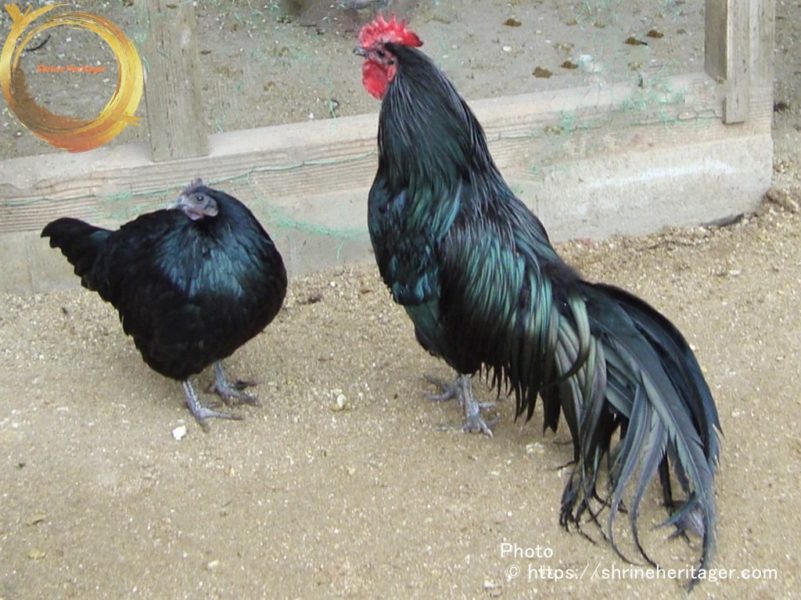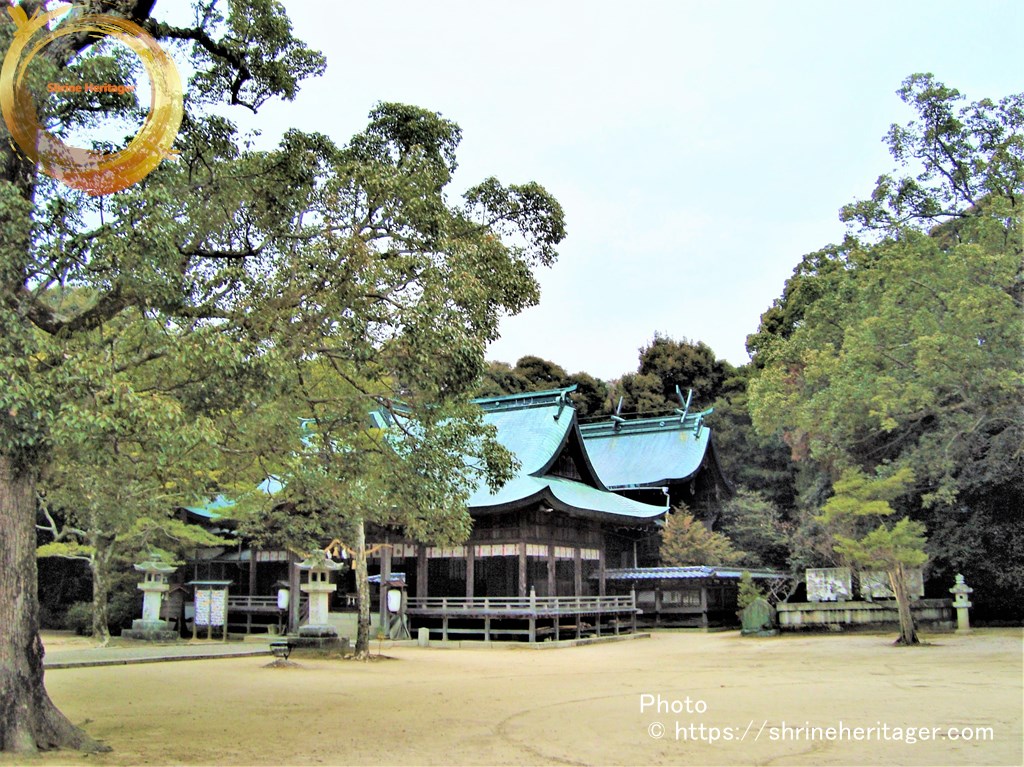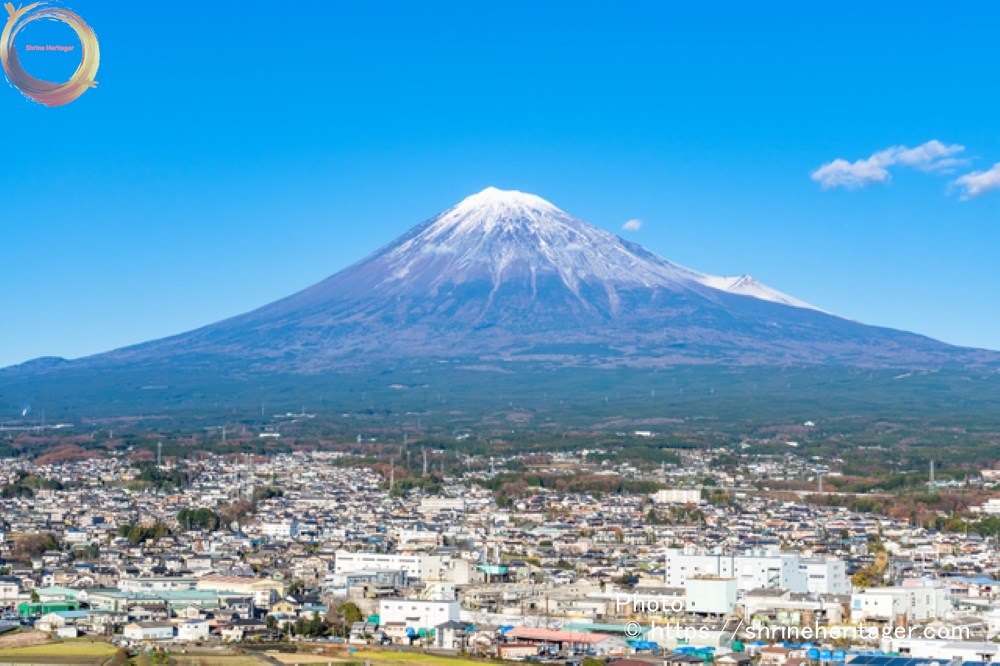Tamanoya shrine (Hofu City) is listed as "Tamaso Shrine Niza" in 『延喜式神名帳(engishiki jimmeicho)』 God Name Book. ) as the god of the festival, but the god of the other one is unknown, and in the company's story, the Tsunesei Naganary chicken collected and played at the time of "Iwato Kakure of the Heavens of Ameteru Ogami" famous for "Japanese mythology" is the god of the festival . It is said that "玉祖命(tamanoya no mikoto)" was taken to this place and stayed in this place, and it is designated as a natural monument, and it is bred in the precincts.
目次
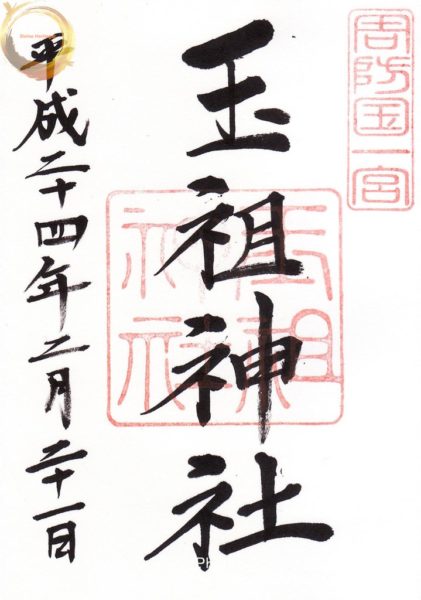
1.ご紹介(Introduction)
The official name of this shrine and how to be called The present address and map I will introduce the history of the god and the shrine enshrined.
【神社名(shrine name)】
玉祖神社(tamanoya shrine) (Hofu City)
(たまのおやじんじゃ)
[通称名(Common name)]
一ノ宮(ichinomiya) たまっさま
【鎮座地 (location) 】
1690 Osaki, Hofu, Yamaguchi Prefecture
[地 図 (Google Map)]
【御祭神 (God's name to pray)】
《主》玉祖命(tamanoya no mikoto)
外一座祭神不詳 [定説はなく 石凝姥命とする説もあり]
【御神格 (God's great power)】(ご利益)
・宝石・眼鏡守護 The god of protection of jewelry and glasses
・豊漁海上安全 Large fish catch and maritime safety
・陶芸業守護 God protecting the pottery industry
【格 式 (Rules of dignity) 】
・『延喜式神名帳(engishiki jimmeicho)』所載社
・ 周防国一之宮(suonokuni ichinomiya)
・ 別表神社
【創 建 (Beginning of history)】
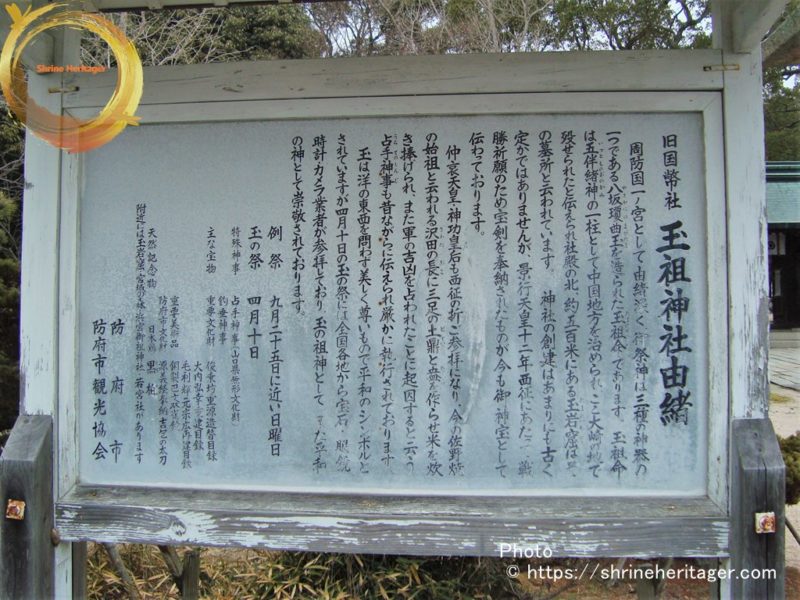
The Old Kuni Mint Tamanoya shrine
As Suokoku Ichinomiya, it has a long history, and the God of the Festival is 玉祖命(tamanoya no mikoto), which was built with 八坂瓊曲玉(yasakanino magatama), one of the three kinds of divine instruments.
It is said 玉祖命(tamanoya no mikoto) was governed by the Chugoku region as one of the five gods, and died here in Osaki.
The construction of the shrine is too old. It is not certain, but in the 12th year of Emperor Kageyuki, the sword of the treasure was devoted to praying for victory in the west conquest, and it is still passed down as a sacred treasure."Emperor Chuai" and "Empress Jingu" also visited this shrine at the time of the Western conquest. At that time, I had three sets of earthenware made by "Sawada no Oasa," the founder of the current "Sano ware." Rice was cooked in the earthenware and dedicated to God. In addition, in the legend, "占手神事Uraten Shinji", which is said to be caused by the fortune-telling of the army's fortune, has also been passed down as it was in the past. Even now, it is strictly enforced.
The "tama" is a beautiful and precious symbol of peace regardless of the east or west of the western world. Jewels, eyeglasses, watches, and camera companies from all over the country are worshiping at the "Tama Festival" on April 10. It is revered as the ancestor of the ball and the god of peace.
Regular festival Sunday near September 25th
Ball Festival April 10Special Shinto "Ura-te no Shinji" (Yamaguchi Prefecture Intangible Cultural Property)
釣垂神事tsuritare no shinji主な宝物 重要文化財 俊乗坊重源造替目録
大内弘幸重建目録
毛利輝元宗広再建目録
重要美術品 銅製巴文双雀鏡
防府市文化財 源義経奉納吉包の太刀Natural monument Japanese chicken KuroKashiwa
In the vicinity are the Tamaiwao Cave, Miyagi Forest, Hamamiya Mioya Shrine, and Wakamiya ShrineHofu City Tourism Association Precinct Guide Board
【由 緒 (history)】
式内社、周防国一宮、旧国幣中社
Tamanoya shrine
Shrine name In the old books, "玉祖" is referred to as "Tamaoyano" or "Tamanooyano", but since ancient times it was Ichinomiya, the country of Suo, so the name "Ichinomiya" was used in the Middle Ages. In the Edo period, the name "Ichinomiya Tamazosha" (Ichinomiya Tamanoyasha) was common. It has been unified to the name of Tama no Shrine (Tama no Oya Jinja) since 1871, when it was classified as a national shrine.
御祭神 (God's name to pray) The name of the god is not specified in 『延喜式神名帳(engishiki jimmeicho)』 , which is the two-seat Gyokuso Shrine, but the main deity is 玉祖命(tamanoya no mikoto) and the other one is unknown.
Tamaso life is one of three kinds of divine instruments in the father god of Tamazoren (Tamari no Muraji), also known as "Sakarutama-no-Miko", "Hakatama-no-Miko", "Toyama-no-Miko", Tamaya-no-Mi (Tamano-no-Mi) and Tamaya-no-Mi (Tamano-no-Miwa).
In the god lord Tsuchiya family document and the long-lasting climate inundity plan, the unknown party is Amanogami-son (Ame-kagami-only) and Tennen-kami-son (Amanokami-only), and the mirror is looked up to as the Sun God as the Spirit's generation. It is said that it is a great god, but there is also a time when Hamamiya Goso Shrine (Hamamiya Ojija) was placed as the god of Heaven, and there is an old custom that always visits Hamamiya Goso Shrine in the first shrine of the girl in the Ojiko, There is no established theory yet, such as the one that the god of the festival is a goddess, and the theory that it is the mother god of Tamaso life.
However, it is always an offer of the offering of two seats at the festival.由緒・沿革 The history and history Oftensho Ogami's Teniwa To hide the Shinto event, Tamaso Life was made Yasaka Kokudama, and it is a record that Tensun Nigi-san (Nigi-no-koto) was assisted in the founding of the national land rule as a pillar of the God of The Five Companions (tokinokami) which was served at the time of his coming to the sun.
In the company's message, we later sat in the land of Ozamae (Osaki, Osaki) to establish the Chinese region, and after finally avoiding God in this place, we buried it in the land of Miso and Era (Tamanoiwaya) and enshrined the spirit of our company. Since then, it is thought that Mr. Tamazo Ren Tamaso was responsible for the ritual, and the name of the 500-backed Tamazobe is also in the Suokuni Tax Book of Tenpei 10 years (738) in the historical document. In addition, the name of Miyaji Tamaso Soko can be seen in the story volume 17 of the old days in the fourth year of Nagatoku (998).
In the company record, it is said that it is Miyagi forest in the north of Tamaso Shrine that the place of service was set up in the 砌 of Emperor Kageyuki (82) Chikushi Yuki, and the shrine was set up in The Saba, and the set sword was dedicated, but it is dedicated as a treasure sword deep into the Imperial Hall now.
In addition, emperor Nakasa and Empress Shingong's West March also arrived at the beach called Yorie (west-south of the shrine), and with the soil of Takada, Sawada-cho (the founder of Sano Pottery) made a three-footed earthenware (nabe) and HIRAKA (hachi), and the good luck of the army was made with a divine offering. This is the origin of the astrodes Shinto, which is still transmitted today.
If you trace the history with reliable historical materials,
For three years from 8 (736) to 10 years, 39 stones and 2 tsubo 8 tsubo of Tamaso Shrine territory were dedicated as a god tax with 頴 rice 3834 bundles from the positive tax of Suokoku the following year. Depending on the divine life, 200 bundles are paid to the 500-back of the strange tama-ykube.
In the year of Daido (806), five houses were given in addition to the conventional ten sealed doors.
貞観9年(867)3月10日、神階従四位下より従三位に昇る。
延長5年(927)延喜式神名帳に玉祖神社2座と載る。
康保元年(964)4月2日、神階正二位から従一位を授る。
平安時代には田島庄、小俣庄、高墓庄の3荘園が寄進される。
長徳4年(998)今昔物語中に周防国一宮玉祖大神と全国一ノ宮の初見となる。
天治2年(1125)安芸權介藤原實明によって荘園並びに神社敷地ともども鳥羽天皇中宮の待賢門院に寄進される。
保延3年(1137)實明の寄進状及び公験に基づいて京都花園の法金剛院に寄進。
永萬元年(1165)神祇官から名神諸社に進物が下された際、大榑(材木)300寸が給される。
建久6年(1195)8月5日、俊乗坊重源周防に下向、東大寺再興の功を偏に玉祖大明神の加護によるところとし、当社造替の工を起し、神宝を調進し、9月28日遷宮の儀を終える。日別供料の料田として10町歩の田地を奉免する。同日、造替目録を作成し改築の趣旨を述べる。
建武2年(1335)9月、大内弘幸が社殿・神宝を造営。
正平11年(1356)僧命俊、九曜巴文双雀鏡を奉納。
長禄元年(1457)8月、田島(防府市中関)の氏子分離し岡庄(中関南山手)に玉祖神社を祀る。
文明11年(1479)12月8日、大内政弘に差出した一宮玉祖社御神用米在所注文は大前(崎)村、宇野令、湯田保、黒河保、千代丸、下松出作、富海保、西仁井令、佐波令平井の10個所に及ぶ。
明応6年(1497)4月16日、大内義興参詣し神馬を寄進。
天正17年(1589)11月2日、毛利輝元、社領200石を寄進。
この年より文禄5年(1596慶長元年)4月23日までの打渡坪付に法金剛院、得楽坊、菊楽坊、正満坊善得坊、正法院、宝持院、藏満坊、行泉坊の名が見える。
慶長3年(1598)9月、社殿、社坊、社人の屋敷等も悉く焼亡す。
慶長14年(1609)9月、毛利秀就社殿再興。
寛永21年(1644正保元年)8月、鳥居建立。
明暦3年(1657)8月、毛利就信(右田毛利)馬場に大鳥居建立。
寛保元年(1741)9月19日、往昔供僧12口ありしが、11ケ寺はことごとく断絶寺屋敷も不明となり、別当得楽坊のみが残存す。
In July 1750, the shrine was re-built by Sohiro Merri. At the same time, Taki naga ANI pays for Tamaso Jinki and three other volumes. In the sentence, he said, "At the time of the memorial service of the Minamoto Yoshikeihei family, I pray for a victory by dedicing Yoshihiro's sword to your company. When it is advanced from Mr. Son Shogun Chikushi, I pray for the fulfillment of the great success by fengbei's sword. The sword of the second wave is said to be a shinto vessel to tell now," and the sword of two swings is described in the Ichinomiya treasure keeping diary on March 23, 1759.
In 1854, he repaired the shrine building in 1854.
In 1871, he was listed at the National Mint Kosha by a general government notice.
Sano Wakamiyasha was listed at Tamaso Shrine Setsha in 1868.
In the 10th year of Meiji, Hamamiya Meso Shrine was also listed in Tamaso Shrine Setsha.
Great repair at the expense of the government in 1868.
大正4年国幣中社に昇格。
After the war, the company's case system was abolished, and the former National Mint was distinguished from ordinary shrines as shrines on a separate table, and it became a bespost shrine.
Newly built Gojinko (Treasure Hall) in 1975.
September 1977 Roofs of Temples, Shrines, Shrines, etc.
On April 8, 1982, with the construction of the Sanyo Expressway, Hamamiya Goso Shrine was moved to the site of about 150 mettles to the north of the former company site. The approach to the head office will also be shortened this year.Festival Calendar January 1 New Year's Day Festival February 11 National Foundation Memorial Festival February 17 Prayer Year Festival March 10 Wakamiya Shrine Festival
In March, 33-year-old women 37, 42, 61, and 70-year-old men and women in the Osaki-Sano area discuss and execute the good days. The School of Education
On April 10th, we look up to the divine virtues of the Gods of the Gods of the Festival, who made the Yasaka Uchikidama, and worship them as the main shrines of Tamasa Goso Daijin, who work in glasses, clock cameras, jewelry, etc., and pray for the development of the work and the safety of the family. The spectaocular yakigami Shinto and the astro-take Shinto service are also executed.
April 29 Tenka Matsuri May Kamigo no Hitama no Iwaya Matsuri It is held at Tamanoiwaya, which is said to be the tomb of Tamaso life. June 30 The Ogo Ceremony in July (Tamichi Goyuki)
On Sunday near September 25th, the day before the Tsutsure-no-Shinji饌 is held on the eve of the festival, and in the early morning of the day before the festival, three feet of earthenware cook white rice and black rice are cooked and offered to HIRAKA. After sunset, we went to Hamamiya Goso Shrine. Both are special Shinto shinto services from ancient time. Before the solar calendar, August 14th and 15th were major festivals.
November 15 Shichi-Gossele November 23 Shinjo Matsuri December 31Special Shinto
Saitake Matsuri (Ohatake) This is a Shinto shrine that creates a new pouring rope before the festival and decorates it with a bereaved bamboo. In the third year of the Horyo calendar (1753), the record of the Shinto priest Tsuchiya family was "Yatsushima Hisai Take Matsuri, Omatsuri Ori, Otorii-kiri 餝 Aisai, Sosha-no-Kinno-ren, Uchitorii Junren Festival. 18 houses called Miyatsuki (Miyatsuki) of the ancient Osaki Iaye make a note rope, decorate the torii with abhorrent bamboo, put a plan under one torii gate when it is finished, offer a shinto sake and a salt water bowl, and the Shinto ritual reads a large article, and the shinto shrine reads a large phrase, and it is osamued by taking a salt water bowl. After that, the Shinto shrine sake of Miyazuke was put on, and this Shinto shrine was finished, but now it is worked on the making of the pouring rope and the abomination bamboo decoration in the self-governing association unit of Osaki and Sano district.
釣垂神事(つりたれのしんじ) On the day before the Festival, Shinto priests will visit Tajimaura饌 (Nakaura, Hofu City), place a god 籬 on the seaside, offer fishing gear in addition to gods, and other people from the Nakaura Fisheries Association will attend to perform the festival to pray for the reasons of Shinto rituals and the safety of the rich fishing sea. The fish which the union member fished out later and caught is brought to the head office on the day of the great festival, and it 饌 god's hand. In our old record, "August festival, old days started Mairaku at The Imperial Shrine (Hamamiya Meso Shrine) on the 15th of August. Right Hi-Fishing Boat Abortion There is a weather that comes from Tajima at the time of the festival ritual from Tajima instead of the ship, and you can know the state of the Shinto ritual of the old days. The present Fishing Gods were re-established in commemoration of the 2600th anniversary of the Showa 15th anniversary, and they continued to be executed without abortion during the post-war period of confusion.
It is an intangible folk cultural property designated by Yamaguchi Prefecture. On the eve of the festival, a series of ropes are placed in front of the shrine gate, and 燎 in the garden. 砌 of the san korean march of Empress Shingong in the company's message, it is made to pray for the victory of the war to our company, this Shinto ceremony is executed, the good fortune of the deed is divinely occupied by the hand, and it extends to today as a special Shinto event of our company 茲 coming. In the Suoji magazine's draft proposal, "Emperor Nakasa Emperor Shingong is also well-paid, and because of the good luck of the army in front of the gods at this time, the remaining tote small sumo wrestling (Ralunokozumo) and the Ifu ceremony, etc.," and also in the long-lasting climate advance plan of Tenpo 13 (1842), it has been added as "Toden Matsuri-no-etsuya" as a tote small sumo. This ancient ceremony is called night sumo because it was performed at the time of the rose (1:00 a.m. to 3:00 a.m.). According to the company's record of the third year of the Horya calendar (1753), it is said that kagura was performed at Night's Noki (11 p.m. to 1:00 a.m.) and went out of Tamagaki to play sumo with a hand, and its shape resembles that of sumo, so it is also called fortune-telling sumo. Shinto shrines begin after the priests and priests sit in front of the shrine gate. 裃 who wore a helmet worked as a judicial officer, two officers of the event place called military officers put a white helmet on the naked body, divided into east and west, seated, sumo 蹲踞 Put both hands on the top of the waist in a similar posture, right left and right, left and right left and both legs go out while bending into the shape of a click, show each person's palm when they come and go, and hit their hips. It repeats three times, and one event ends, and this is done three times for convenience. At the last stage, the soldiers join hands, and the east and the west cross and hit the ground. In normal years, the number is 12 and the leap year is beaten 13 times, and when it is finished, both hands are raised in front of 鬨, and the Shinto service ends when the voice of the god is raised. 鬨 is a completely silent pious Shinto, except for the voice of a man.
In the early morning of the day of the special festival, two pieces of white rice (white rice) and black rice (brown rice) are cooked, and this is served to god 饌 in half to HIRAKA. It is said that this starts from the time of the prayer of Empress Shingong, and the descendants of Mr. Sawada (the founder of Sano pottery potter, who leaves the place name of Sawada in Oji Sano, Hofu City) are from generation to generation. There is an old example that this festival instrument is advanced every year, and alit it continued until about 1955, it was cooked with an oldware because it had an abortion, but in September 1957, the annual advance came to be carried out at the request of the Sano Ware Preservation Society.
At the time of the marching of Emperor Jingo and Empress Chikushi in the old days, The ship was sent to our place, and it ordered the head of Sawada (called Sawa Tanakaki Tsuchida and Imaha Uchida and The Family at that time, Yasaburo family at that time) to make a three-foot earthen pot with the soil of Takada (Takada is the foot of Mt. Hime) and cook the offering, and it was served to dai HIRAKA. It is said that the pot is prepared from the Nobushi Sawada family muscle of the Ichinomiya Festival in August every year without the year 1641 Noma 闕 of this Tenho 12 years old in the example of the Tohi festival festival of the good luck of the army to prepare for the my god of Tamaya. This earthen pot is made of freshly baked, and it can be indected that it was a daily product of the Old Kodeki region. These fragments are excavated from the 瓮 region with pieces such as Yayoi-style earthenware, soil, and debris. That is, it was not a special festival instrument of Tamaso Shrine, and Empress Shingong was ordered to make a new tone for prayer.
According to the company's message, Wakamiya Shrine, which sits in Sano Wakamiya, is said to have prayed that the descendants of Sawada's head worshiped the spirit of Tamaso's life, worshiped him as a god, and prayed for the protection of the ware industry.A place associated with Tamaso Shrine
Miyagimori It is also called Miyakinomori. It is located in Tanaka in the 300-me-tor to the north of the shrine.
In the 12th year of Emperor Kagegye, Kyushu's bear-attacking tribe revolted. On the way to the West March, a woman who called herself "Kami natsu-an" was 酋 in Saba. At the time of the Emperor's death, Kami Natsushima picked a kenki (shaved) from Tsuyama (Tsuyama) and placed 8 swords, 8咫 mirrors, and 8 shakers (balls) on each branch under the top and bottom舳. It is said that the emperor is prayed for victory to Tamaso Shrine, and the trace of the place of service at that time is Miyagi forest. Tamaso Shrine Annex.Mt. Hachigo is located in our company's north and west about 600 mettles. It's commonly known as Sasayama. 糘 Mountain (Symyama). When the shrine was set up in the forest of Emperor Kageyuki Miyagi,
On this mountain, Yagami (the rein deity from the god of god, the spirit god of the high-prince, the heavens and the earth, and the human race were all brought up by the power of these two gods.) The god of production is a god full of fulfilledness. The requiem of the soul is the god who calms down the soul in the body.
Omiya God of Sale is a god who is going to make peace. God of the Imperial Capital is the god who presides over food.
It is said that this name is from the place where it was festivaled, and the festival instrument at that time was buried.玉の岩屋(たまのいわや)Tamanoiwaya "Tamaya-no-Iwaya" "Tamaya-no-Iwaya and Ifu 閭 the Tamanoiwaya to put the Mahi Gojin-an that was hidden in Osaki's (village village). It is known until the time of Ariyuki Tengen in Era which separates three towns 餘 after our company, and it remains a little in the shape now, and it is a test of the small shrine of the near-age stone, and it seems to be a climate pouring plan.," but the present Tamano Iwaya was built in 1868, and the festival is held on May 1st. It is located in the shrine about 500 mettle to the north of the shrine. Tamaso Shrine Annex.
Main Treasures Important Cultural Properties The catalogue of the Treasures of the Suokuni Ichinomiya Temple, etc. In March, 1195, a heavy source that took ten years to rebuild the Todaiji Daibutsu-den was added to the protection of The Great Myojin. To thank you, it is an inventory of the buildings below the shrine and treasures such as the Obookdai, mikoshi, and Gotsuka belt, which went down to Suokoku on August 5 of the same year and re-built the Tamaso Shrine between The 7th of the same month and September 28.
The purpose is stated at the end, and the rice field of 10 town walks is consemised as a charge field of the monthly offering fee by the end. In the catalogue of the rebuilding that took place in the 140th year since the rebuilding of the Shigemoto, the volume of the suokuni Ichinomiya Tamaso Shrine, the number of shrines, Shinto priests, and monks is described, including the size of the shrine.
It is from September 1335, the second year of the construction of Hiroyuki Ouchi. It is a valuable document that describes the location and area of the shrine territory of the god rice of Tamaso Shrine which was put out to Masahiro Ouchi in December of civilization 11 years of civilization 11 years (1479), and it is a valuable material to tell how Tamaso Shrine retained its scale as one of the shrines of the Todaiji territory after the heavy source with the above inventory.重要美術品 Important works of art Copper Kuyo-mon Sojaku Mirror One side Shohei 11 (1356) Monk Life Shun was dedicated, and when the shrine hall was on fire in 1598, it was on fire, and the skin of the mirror surface was damaged, but the pattern is well in its original form.
It is the work of Yoshinagan, which is said to be one of the last swordsworkers in Kobi-in, one of the city-designated cultural properties, and is 80. It is 5 cm, 2 cm warped, and it is a sly building, a sly building, and a straight sword.
It is said that Minamoto Yoshiyoshi prayed for victory and dedicated it when the Hei family was chased in the company news.It is said to be the work of a famous sword worker Nobukuni of the north and south morning period, and the length 73. 4 cm, warped 2. The stem (the basket) is a sliding stem with 2 cm, a shaving, a building, and a straight sword.
It is accompanied by Anami origami with the words "Shinkoku Masamasa Sa 2 shaku 4 minutes 1 minute and a half in nameless front and back Ariyuki Tonko 10 sheets of Enho 7 years not May 3 Hona (flower press)". It is the dedication of Kiyoishi Kondo. Many other old mirrors, documents, etc.Natural Monuments
Japanese chicken Kurosewa A precious Japanese chicken that is slightly bred in the area of Yamaguchi and Shimane prefectures.
On June 9, 1951, it was designated as a natural monument by the Committee for the Protection of Cultural Properties.
The feathers are green-purple black with metallic luster. Nagao chicken of the small country lineage, Naganaki chicken.
In the company's story, it is said that it was this ebony that collected the Tsunesei Naganaryu chicken and made it sound at the time of Iwato hide of the heavens of Aesu Daijin, and Tamaso life took this chicken after that, and it stayed here in the land of Osaki.
It is bred in the shrine precincts as the birthplace of ebony.(注一)一の宮 国中第一の神社をいい、原則として一国に一社ある。恐らく最初から全国的に定まったものではなく、神位・信仰・勢力等の最も著しい神社をその国の一宮として尊崇したのが起りで、それが漸次全国的に普及すると共に、準公的な権威・社格をもつに至ったと考えられる。平安中期に現われ、鎌倉時代には全国的になっていた。今昔物語の中に周防一ノ宮玉祖大明神と書かれているのが全国一宮の最初の記録である。
(注二)国幣社 明治4年太政官布告による社格の一つ。この布告で国家自らが経営する神社を官社、それ以外の神社を諸社と称することに定められた。官社には官幣大社・官幣中社・官幣小社・国幣大社・国幣中社・国幣小社の6つ、諸社には府社・藩社・県社・郷社・村社の6つが設けられた。明治6年に官社のうちに新たに別格官幣社が加えられた。別格官幣社は歴史上の功臣で神に祭られた神社で、官幣社には例祭に際して皇室から、国幣社には同じく国庫から幣帛料が供進された。この社格制度は戦後廃止され、旧官社は現在別表神社として一般の神社と区別さていれる
(注三)式内社 醍醐天皇の詔命によって延喜7年(907)編纂に着手し、20年を要して延長5年(927)に完成した延喜式(五十巻)の第九・十巻〔神名帳〕にその名を登載された神社を式内社という。玉祖神社二座と載る。当時の制で、毎年2月祈年祭にあたり、神祇官或は国司より奉幣に預るものを官舎といい、他の一般神社と別の待遇を得た。
(注)文中のHIRAKAは「皿」偏に央です。YORIは古文書の「より」、KOTOは「こと」です「全国神社祭祀祭礼総合調査(平成7年)」[神社本庁]
【境内社 (Other deities within the precincts)】
・濱宮御祖神社《主》天鏡尊
・若宮社《主》玉祖命
スポンサーリンク
この神社の予備知識(Preliminary knowledge of this shrine)
This shrine has a long history.
『延喜式神名帳(engishiki jimmeicho)The two volumes that are regarded as important among all 50 ritual- style scrolls created by the Imperial Court during the middle Heian period are called " engishiki jimmeicho " (edited in December 927). Approximately 1100 years ago, the name of "2861 company" and the number of gods enshrined there are listed in the list of government offices (shikinaisha) nationwide.
【延喜式神名帳】(engishiki jimmeicho)The shrine record was completed in December 927 AD.
[旧 行政区分](Old administrative district)
(神様の鎮座数)山陽道 140座…大16(うち預月次新嘗4)・小124
[旧 国 名 ](old county name)
(神様の鎮座数)周防国 10座(並小)
[旧 郡 名 ](old region name)
(神様の鎮座数)佐波郡 6座(並小)
[名神大 大 小] 式内小社
[旧 神社名 ] 玉祖神社 二座
[ふ り が な ](たまのをやの かみのやしろ にざ)
[How to read] (tama no woya no kamino yashiro niza)
https://www.digital.archives.go.jp/DAS/meta/listPhoto?LANG=default&BID=F1000000000000004146&ID=M2014101719562090086&TYPE=&NO=画像利用
国立国会図書館デジタルコレクション 延喜式 刊本(跋刊)[旧蔵者]紅葉山文庫
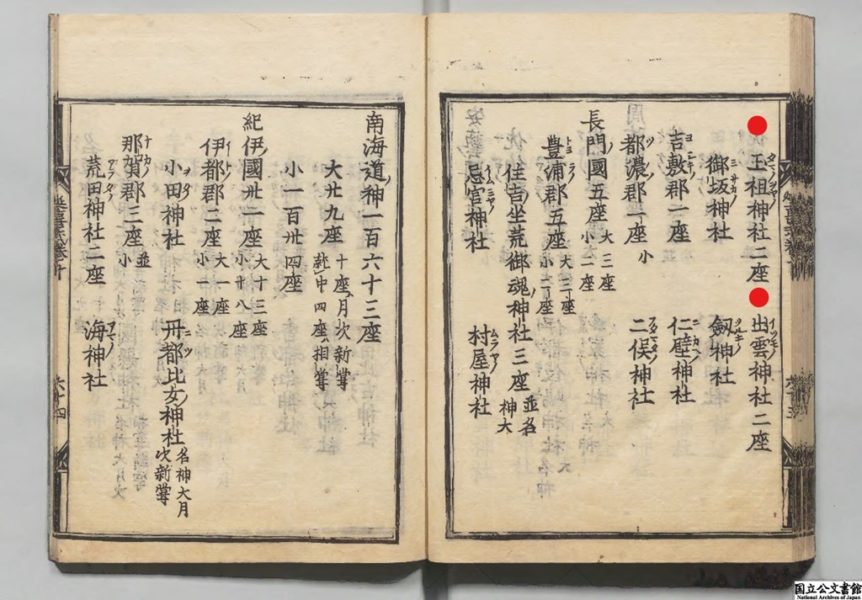
[Otaky Point] (Points Selected by Japan Otaku)
I will introduce the preliminary knowledge that you will be interested in this shrine from a otaku's point of view.
Tamanoya shrine (Hofu City) is the headquarters of Tamaso Shrine.
Tamaso Shrine in Yao City, Osaka Prefecture is said to have been admirated for spirits from Tamaso Shrine in Suokoku in
710 (3rd year of Japanese copper) Please see the article of Tamaso Shrine (Yao City).
スポンサーリンク
Visit the Shrine (Pray at the Shrine)
I introduce the state when I visited this shrine.
About 5 minutes by car from Hofu Nishi
I.C. on the Sanyo Expressway from Hofu Station via Prefectural Road 54 about 4.6km by car 10 minutes
Arrived at Tamanoya shrine (Hofu City)
"One Torii" is built on the approach to Tamanoya shrine, and there is a second parking lot just to the right.
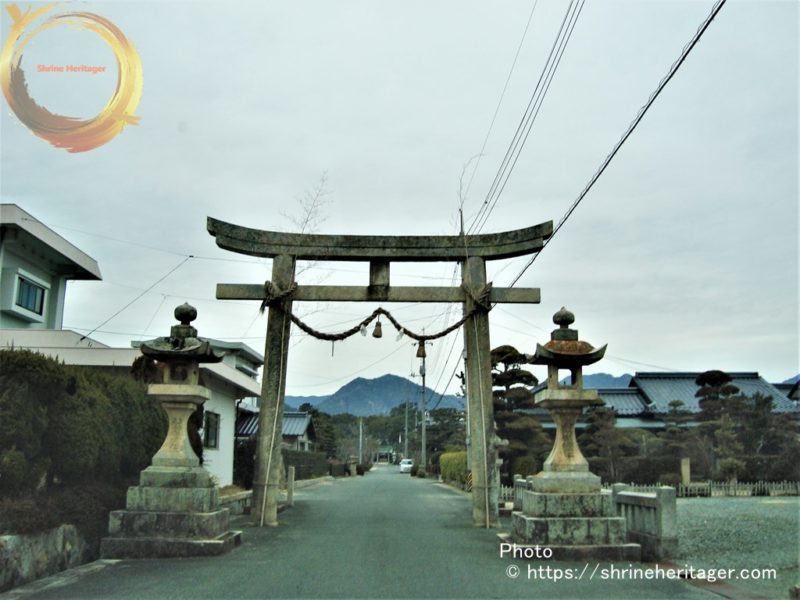
At the head of the company, there is a stone lantern torii gate on the right side of the shrine.
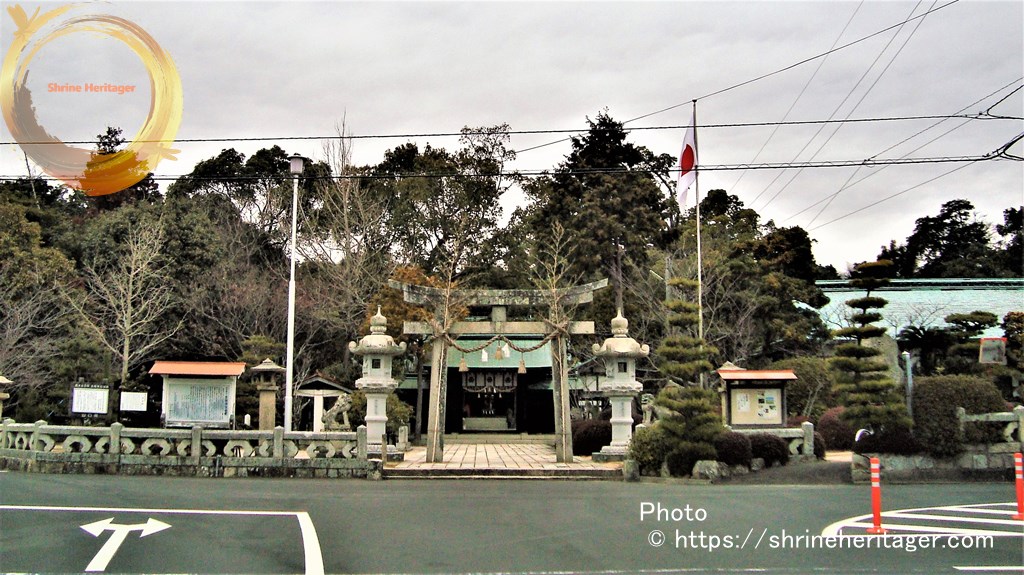
Bow, go through the torii and go to the precincts.
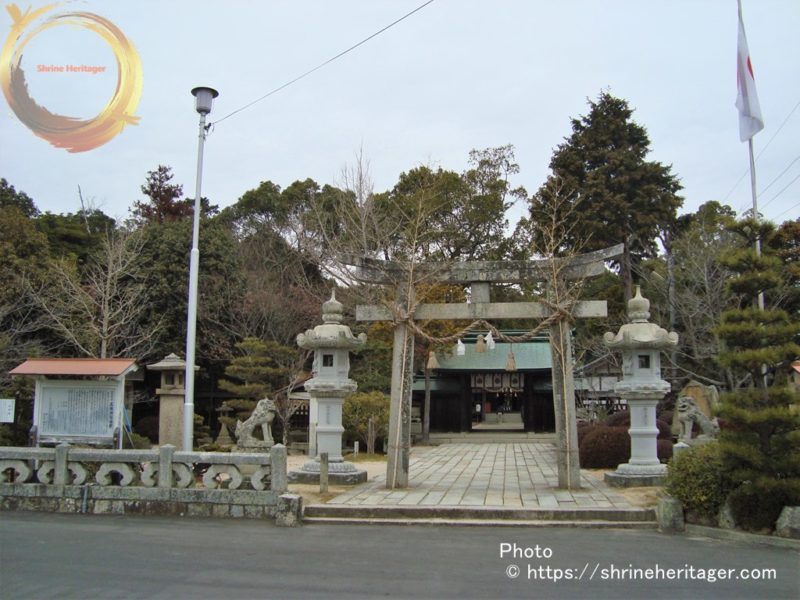
"Shiba Inu" written as "Cultural 9th Year (1812)" is set up
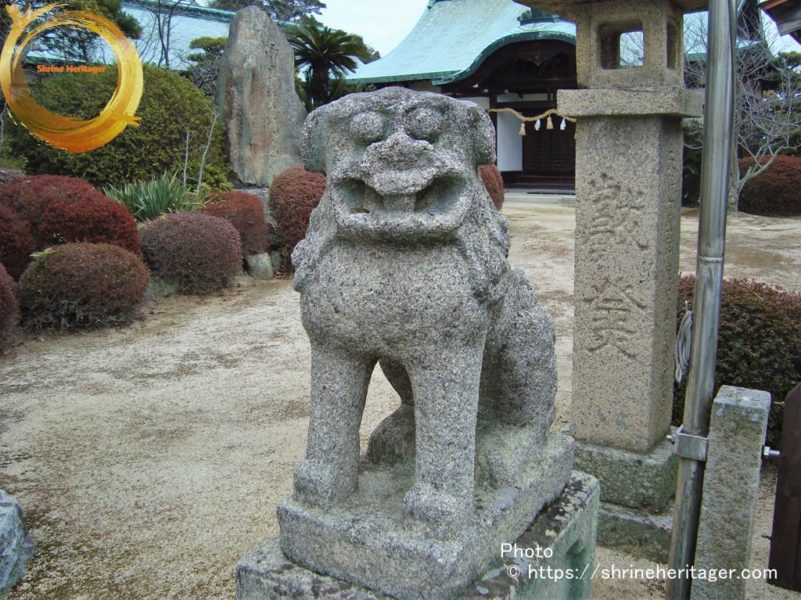
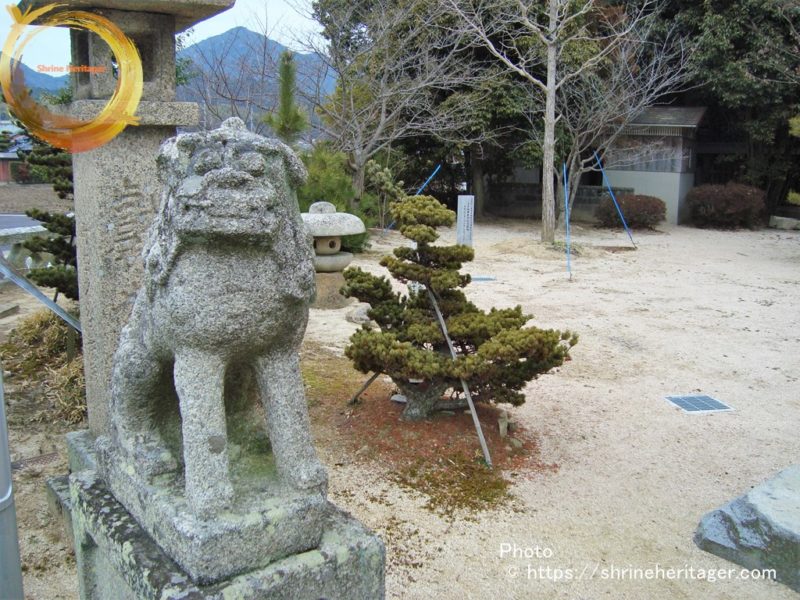
A stone monument is engraved with "Natural Monument: The Birthplace of Japanese Chicken Kuroshima"
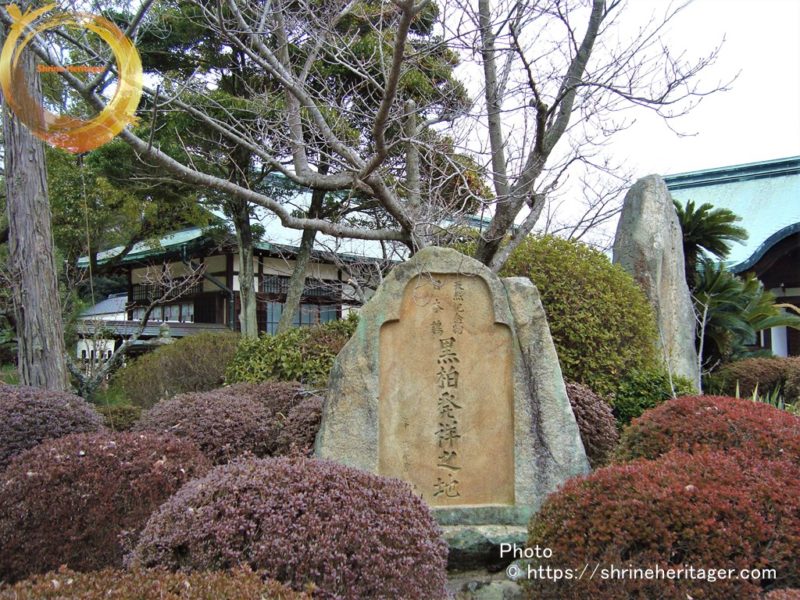
There is a Shinto gate, and Shiba Inu is set up again.
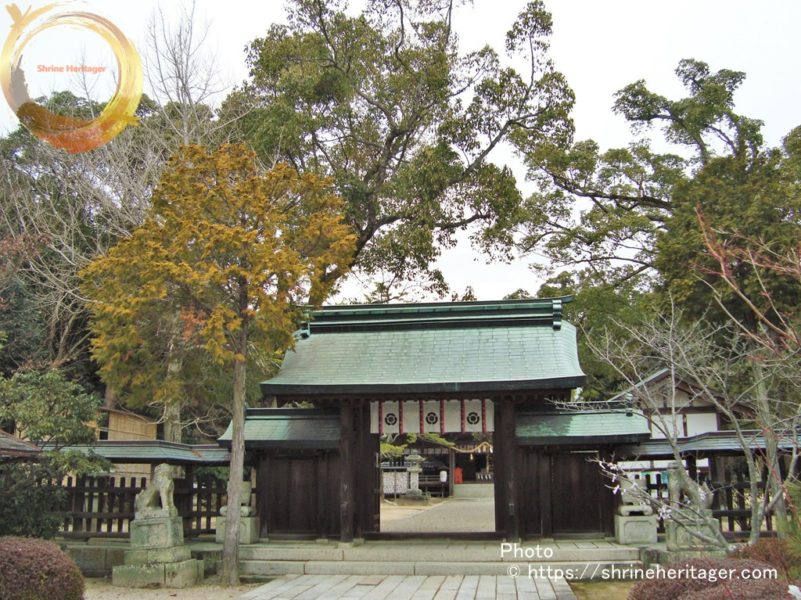
I bow and go through the Shinto gate.
The god crest is dyed on the shinto screen, and if you look closely, it is kameko's god crest in the crest of the magatama.
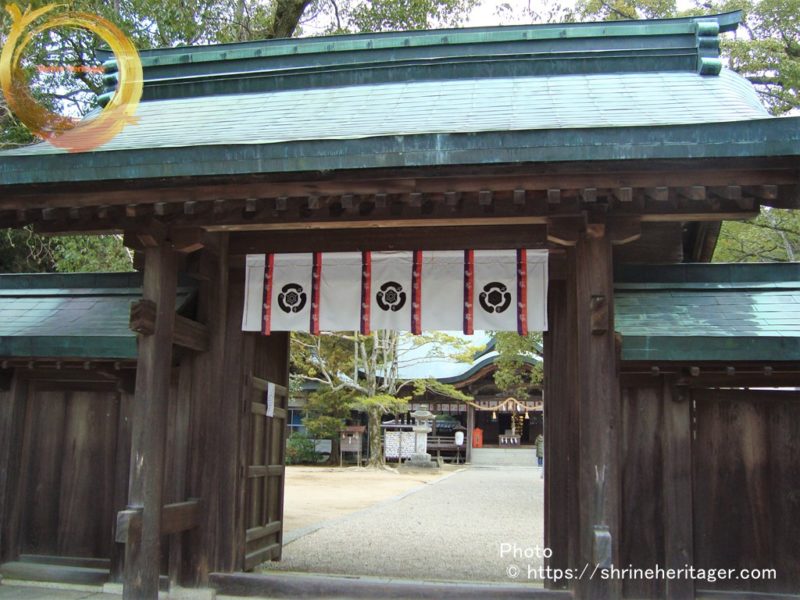
There is a chicken coop where the stone monument "Kurosa" is bred a while ago
It is said that it was called a long cry in the chicken which came with The Advent of Tendun after all
The cry of the ebony seems to reach 10 seconds in the long one of 7 to 8 seconds.
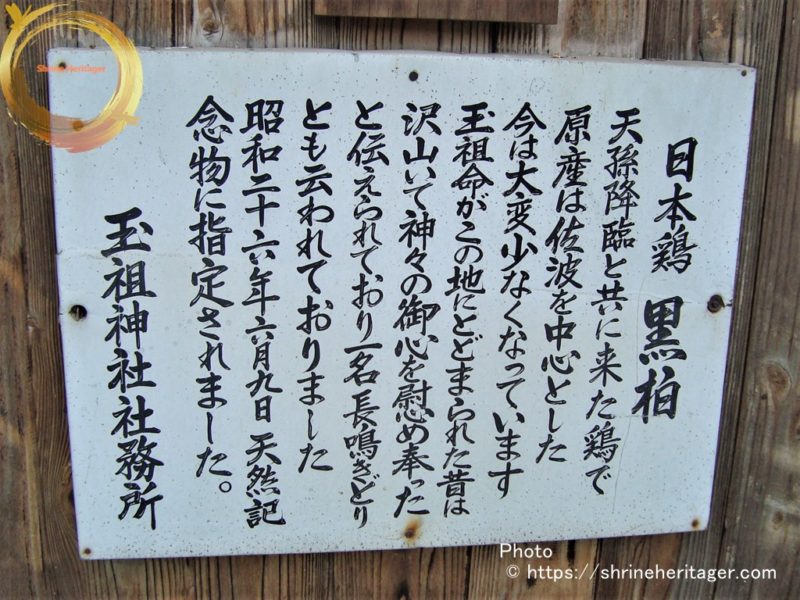
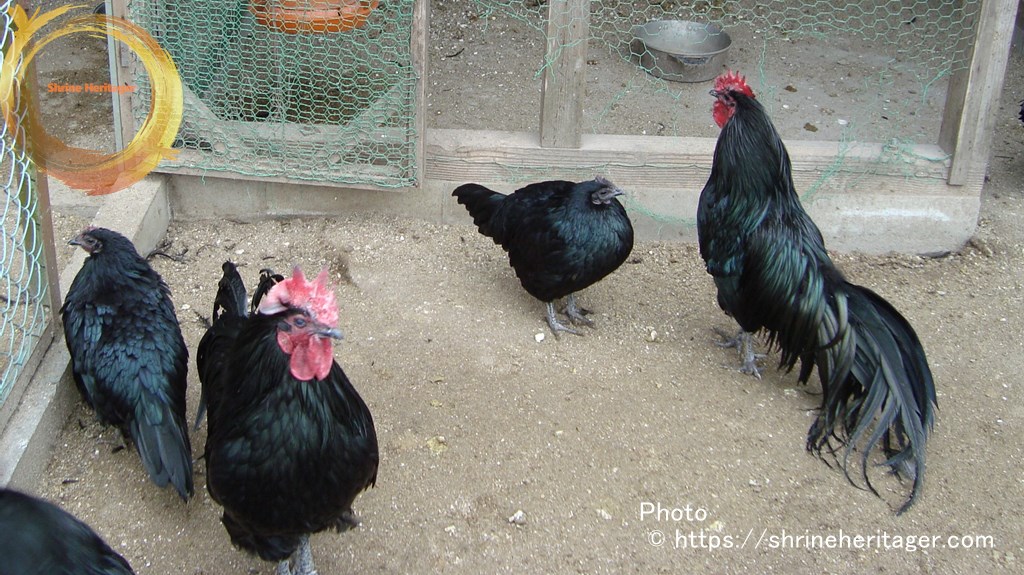
It is said that "Tamanoya Ichinomiya" is put on the flat forehead in the worship hall.

Give me a prayer.
When you reach the god of worship, where you worship God's power, pray with your hands together.
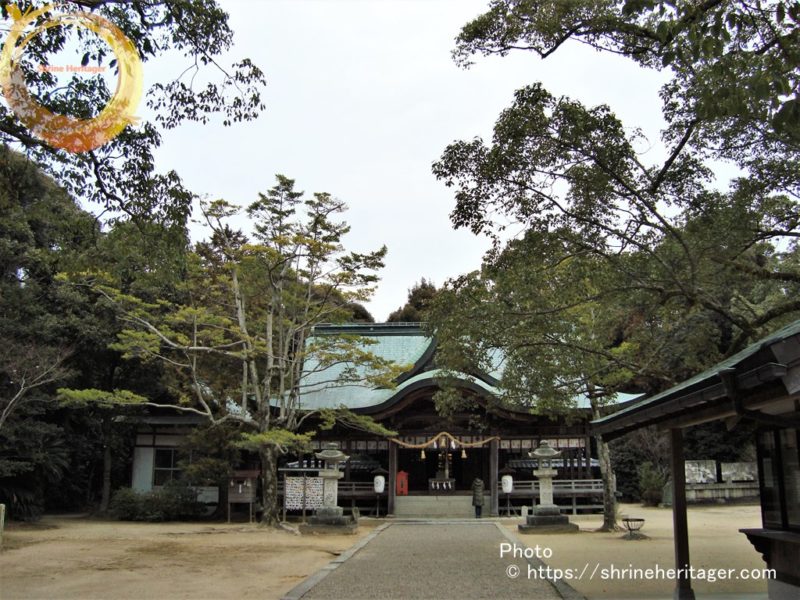
Turn to the back and look up at the main shrine.
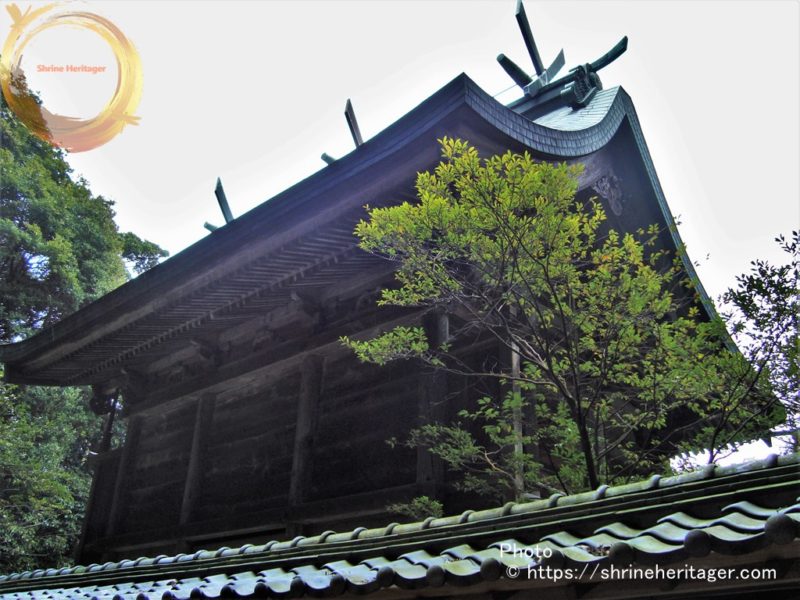
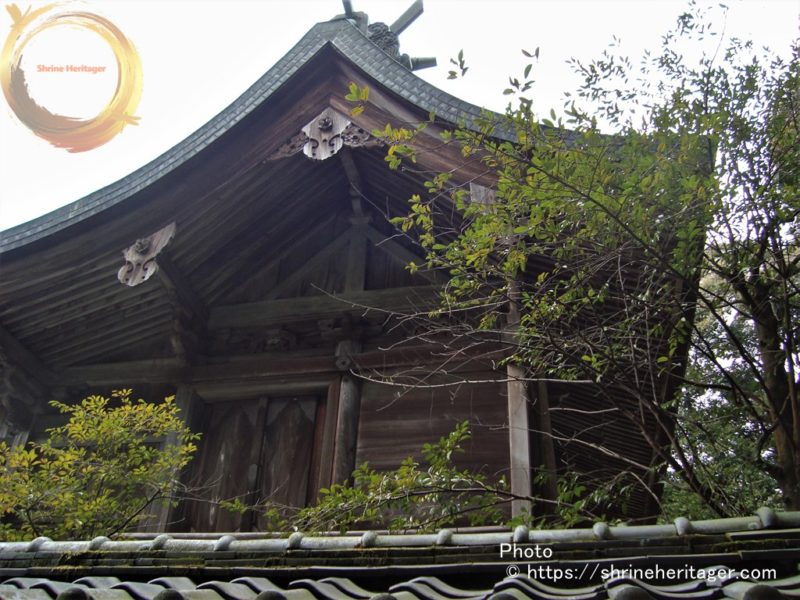
I'm going back to the approach.
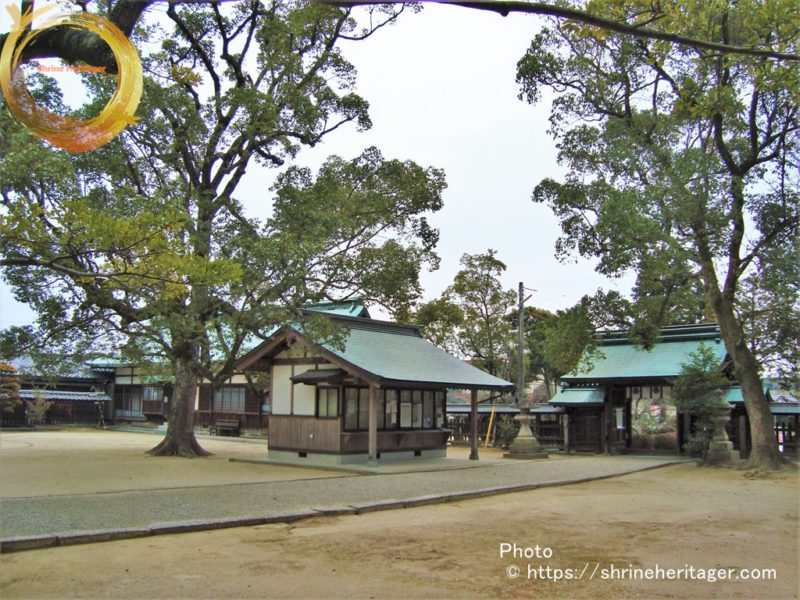
I'll go through the Shinto gate, I'll go through the torii gate, I'll look back and bow.

There is a shrine card awarding place in the precincts, but in the case of absence, there was a paper that says at the shrine hall next to one torii, so I was awarded a return to the first torii gate.
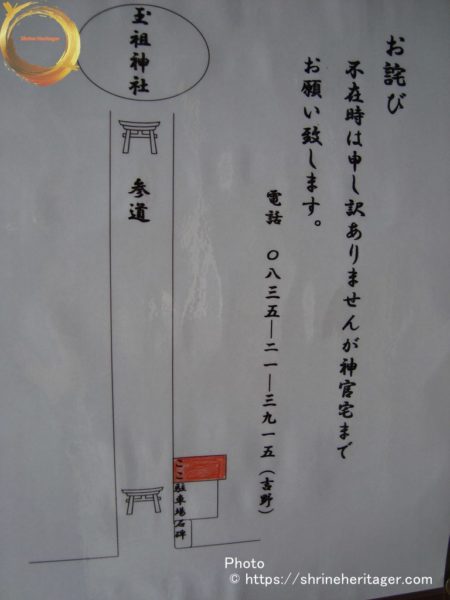
スポンサーリンク
神社の伝承(Old tales handed down to shrines)
I introduce the thing related to this shrine and the literature described.
『古事記(kojiki)』A tradition written in ame no Iwatoya
The famous "Japanese mythology". Amaterasu Omikami ordered "玉祖命(tamanoya no mikoto)" to make a jade decoration when hidden in Iwato. It says, "A lot of "八坂瓊曲玉(yasakanino magatama)"", and go through them in a long time. " "The long-lasting songbird of Tokiyo" will also appear.
Nordhaven
"Amaterasu Omikami was afraid to see it. He opened the door of the ameno Ishiya and put it inside. Then, "Takamagahara" became completely dark. "Ashihara Nakatsukuni" has also become completely dark. The night went on all the way.
There, the roaring voices of many gods, in May, were full, like the frying flies, and all the annoyances all occurred.
このような状況を受け、「天の平和の川」に自然に集まった「800万の神々」が、「たかみつむすひの神」の子である「想いかねの神」に解決策を考えさせた。 そうだった。
First of all, collect the long-lasting songbirds of Tokiyo and let them sing.
Take the hard stones above the river of "Ameno Yasugawara" and take the iron of Heaven's gold mine to find the blacksmith "Amatsu Mara".
Ask "Ishikori Dome no Mikoto"伊斯許理度売命to make a mirror.
God has been commanded to "玉祖命(tamanoya no mikoto)." Then, I made many "八坂瓊曲玉(yasakanino magatama)" and pierced them for a long time.
天児屋命(ameno koyaneno mikoto)God called "Futo Tamano Mikoto," and completely removed the shoulder bones of the stag of "天香山(amenokaguyama)," and then took the "Kaniwa cherry tree" of "天香山(amenokaguyama)," I grilled the deer bones and made them fortune.
We have dug up the thick Sakaki of "天香山(amenokaguyama)", and put a lot of "八坂瓊曲玉(yasakanino magatama)" on the branch above it, and put a ball ornament that passed through a long string. The middle branch was covered with a "八咫鏡(yatanokagami)," and the lower branch was covered with a "white cloth" and a "blue cloth." These various items were given to God by "Futama no Mikoto". 天児屋命(ameno koyane no mikoto)However, He gave God a precious congratulatory speech.
天手力男神(ameno tajikarawo no mikoto)Hiding behind the door
天宇受売命(ameno uzume no mikoto)She put"天香山(amenokaguyama)" vines of Hikage on the side of the sash, put the hair of the Makoto vines on it, and bundled the bamboo leaves of "天香山(amenokaguyama)" into the sample and held it in her hand. And he laid the tub in front of the door of "天石屋(ameno iwatoya)". It stomped on it, and it became as if God had transferred. She exposed her breasts and hung a string on her genitals.Then, many gods laughed so loudly that "Takamagahara" sounded.
Therefore 天照大御神(amaterasuomikami)God seemed strange and opened the door of "天石屋(ameno iwatoya)" narrowly. Looking through from the inside of the door, I said, "I am here. I think "Amahara" is naturally dark, and "Ashihara Nakatsukuni" is all dark. Why is "天宇受売命(ameno uzume no mikoto)" so enjoyable? "Are all the eight million gods laughing?"
So, "天宇受売命(ameno uzume no mikoto)" said to him, "Because there is a precious god here than you, I am joyful, laughing, and having fun."
While saying this 天児屋命(ameno koyane no mikoto) When he showed 天照大御神(amaterasuomikami)天照大御神 (amaterasuomikami)When I look into the mirror, I find it strange, and I gradually come out of the door and look into my reflection in the mirror. At that time, the "手力男神(tajikarawo no kami)" who stood beside him picked up his hand and pulled it out. Immediately after that, "布刀玉命(futotama no mikoto)" ran a pouring rope.天照大御神のうしろに引き渡して申し上げたことには「これから内へおもどりになることは出来ません」と申し上げたthus天照大御神(amaterasuomikami)When we came out, both "Takamagahara" and "Ashihara Nakatsukuni" were shining in the natural light."
【原文参照】『古事記』刊本 明治03年選者:太安万侶/校訂者:長瀬真幸 国立公文書館デジタルアーカイブ
https://www.digital.archives.go.jp/DAS/meta/listPhoto?LANG=default&BID=F1000000000000047416&ID=&TYPE=&NO=画像利用
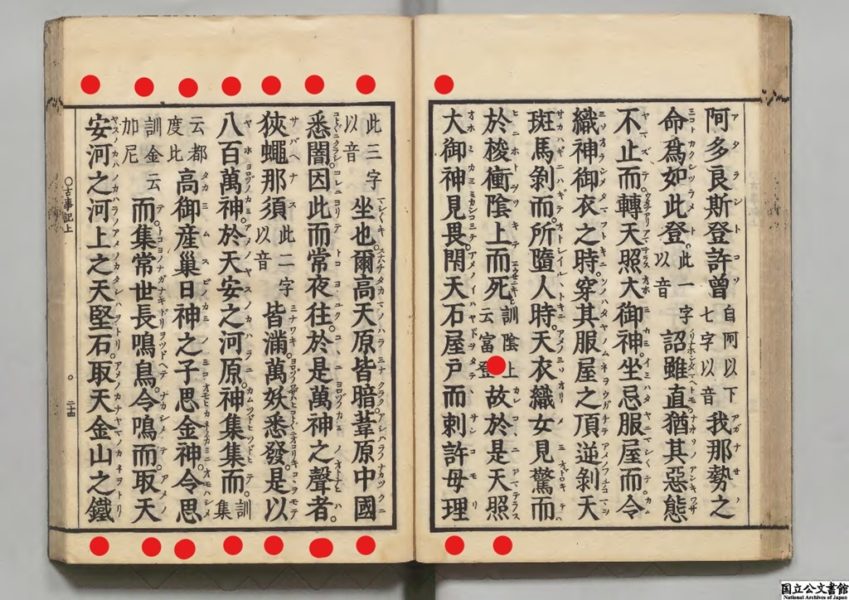
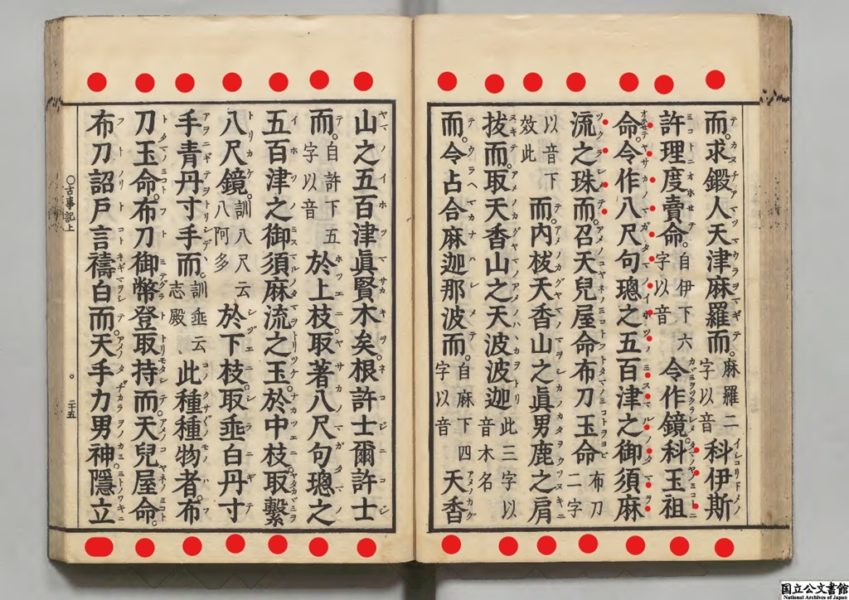
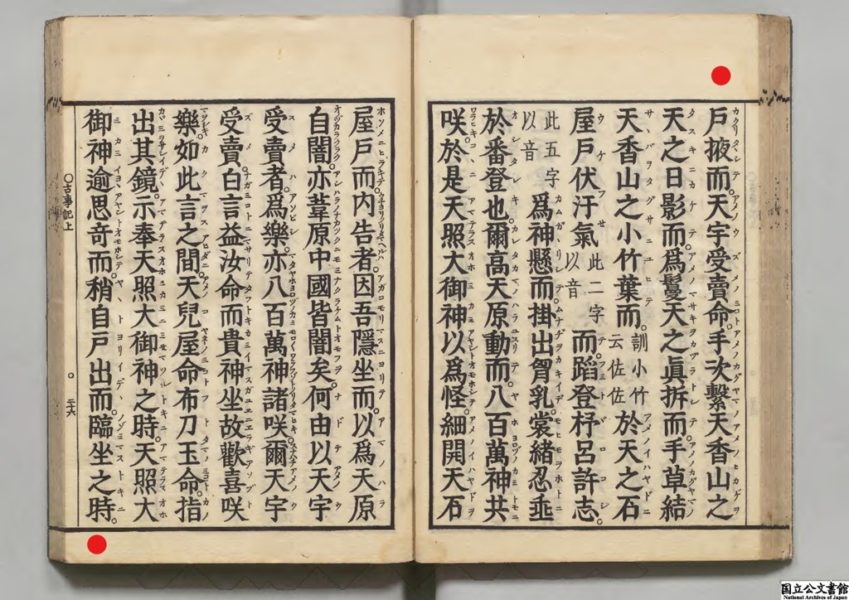

『日本書紀(nihon shoki)』第九段一書 天孫降臨 に記される伝承
The situation regarding "天孫降臨(tensonkorin)" is described along with "God Imperial Relic".
The deity of the shrine is written as "玉屋命(tamanoya no mikoto)" as one of the five pillars of the god who was followed by "Tenson".
Nordhaven
"The two pillar gods go up to heaven and report. "Ashihara China (ashihara no nakatsuku) have all settled already."
At this time, "天照大神(amaterasu omikami)i" becomes "勅(choku)",
"If that's the case, let's get my child down to the ground right away," he said.Exactly, when I was trying to lower my child into the human world from heaven, "the grandson" was born.
His grandson's name is called "天津彦彦火瓊瓊杵尊(amatsu hiko hikoho ninigi no mikoto)."Therefore, "天忍穗耳尊(ameno oshihomimi no mikoto)" told Okami.
"Drop this emperor's grandson from heaven into the human world, instead of me."Therefore, "天照大神(amaterasu omikami)" instructed "瓊瓚杵尊(ninigi no mikoto)".
八坂瓊曲玉(yasakani no magatama)
八咫鏡(yata no kagami)
草薙剣(kusanagi no tsurugi) "三種の神器three sacred treasures" was given.
Also, " 天児屋命(ameno koyane no mikoto)", the ancestor of Mr. Nakatomi
"太玉命(futotama no mikoto)," the ancestor of忌部(imbe)
"天鈿女命(ameno uzume no mikoto)," the ancestor of猿女(sarume)
"石凝姥命(ishikoridome no mikoto)," the ancestor of鏡作(kagamitsukuri)
"玉屋命(tamanoya no mikoto)," the ancestor of玉作(tamatsukuri)
In all, they arranged the five gods to follow the emperor's grandson.
And the "shinchoku" to the grandson is
“The country of Mizuho in Chiihoaki of Ashihara is the country where our descendants should be king. You, the grandson, go and reign. Please go. As long as the amatsu hitsugi thrives, they will not be in poverty forever with heaven and earth." "
【原文参照】『日本書紀』 刊本 文政13年選者 舎人親王[旧蔵者]内務省 国立公文書館デジタルアーカイブ
https://www.digital.archives.go.jp/DAS/meta/listPhoto?LANG=default&BID=F1000000000000047528&ID=M2017042515415226619&TYPE=&NO=画像利用
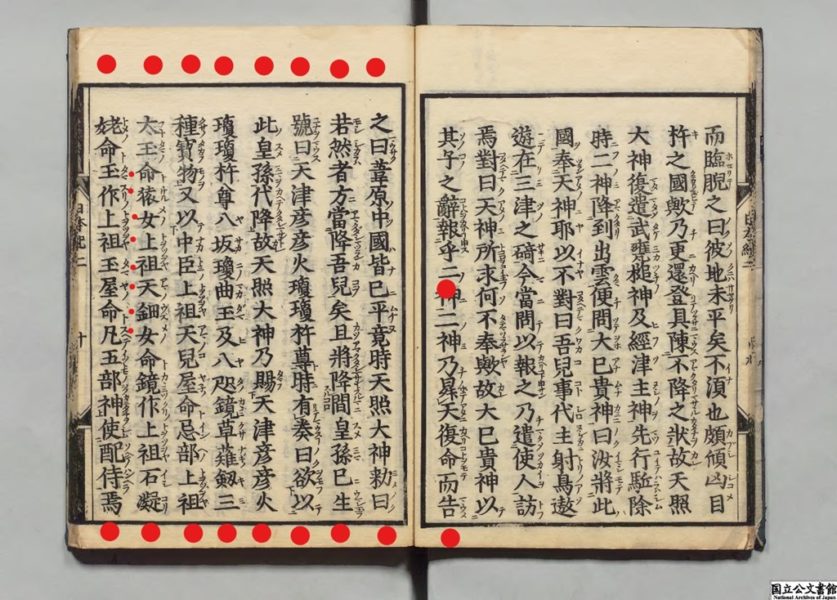
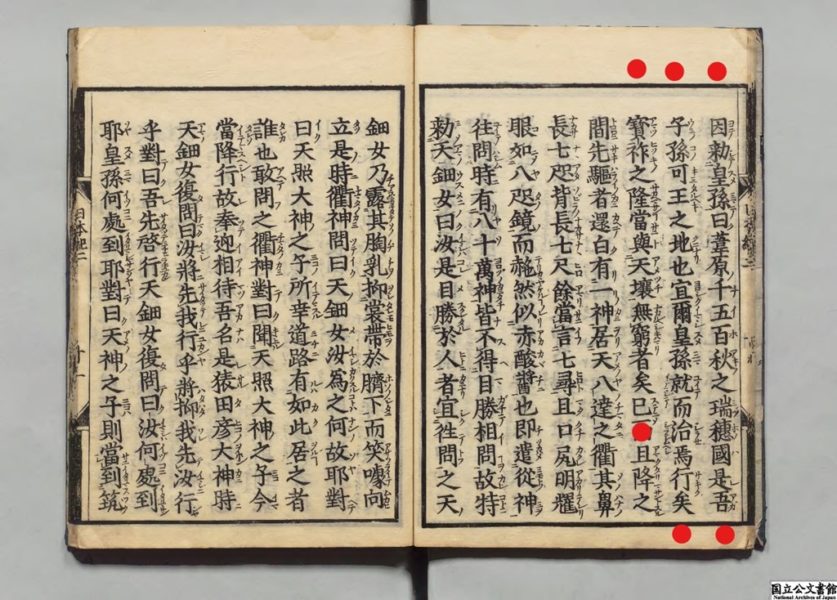
『日本書紀(nihon shoki)』景行天皇 大足彦忍代別天皇 Tradition written in
To subdue the rebelsThe family headed by "Kamunatsuso hime" in this area dedicated the vessel of God. And the clan has reconciled to the Emperor.At this time, it is said that the Emperor prayed for victory at the "玉祖神社(Tamanoya shrine)".
Nordhaven
"Autumn July, 12y. The "kumaso" attacked the Emperor. They did not make a tribute. On August 15, the Emperor headed to "tsukushi".
September 5th. We arrived at saba of Suwa no kuni (currently Sawa, Yamaguchi Prefecture).At that time, the emperor was told by the group (mahetsu no kimitachi) while looking out to the south.
"There is a lot of smoke in the south. There must be bandits."Staying there, first, "武諸木(takemoronoki)", the ancestor of oo no omi, "菟名手(unate)", the ancestor of "kunisaki no omi", monobe I sent "夏花(natsu hana)", the ancestor of you (mononobe no kimi), to the place to find out what it was like.
There is a woman there, who is called "神夏磯媛(kamunatsuso hime)."
Her minions are numerous and the heads of one country.When they heard that the emperor's messenger had come, they pulled out (sakaki) from "shitsuno yama", put "八握剣(yatsukano tsurugi)" on the upper branch, and put it on Nakaeda. He put on a “八咫鏡(yatano kagami)”, put a “八尺瓊(yasakani)” on the lower branch, set a white flag on the bow of the boat, came out, and said,
"Please, don't send soldiers to us. I and my fellows do not disobey the Emperor.
I will surrender immediately.However, there are other bad bandits.
One of them is called "hanatari". They use the name of the Lord without permission, and gather in noisy areas in the mountains and valleys, and are stationed on the river above the "菟狹(usa)".
The next person is the ear lobe耳垂(mimitari). It robs warehouses of reserves, devours them, and often takes people away. This will be stationed on the river "御木(mike)".
The third person is called "asahagi". We are secretly gathering bad guys and are on the river in "Takaha".
4人目は「土折りおり」と呼ばれています。 ミドリノの川に隠されています。 山や川の険しい場所にいる人々を盗み、脅し、搾取します。
These four people all live in a “rugged place”. Each has a companion. It is the head of each region.
Everyone says, "I do not obey the imperial order."
It would be nice to be dealt with promptly. Don't miss them. "Then, "武諸木(takemoronoki)" and others first invited "麻剝(asahagi)". And I gave them various rare things such as "red jacket" and "hakama". And three people who did not obey the Emperor also attracted.
When each came along with the bad guys, they captured and killed all. "
【原文参照】『日本書紀』 刊本 文政13年選者 舎人親王[旧蔵者]内務省 国立公文書館デジタルアーカイブ
https://www.digital.archives.go.jp/DAS/meta/listPhoto?LANG=default&BID=F1000000000000047528&ID=M2017042515415226619&TYPE=&NO=画像利用
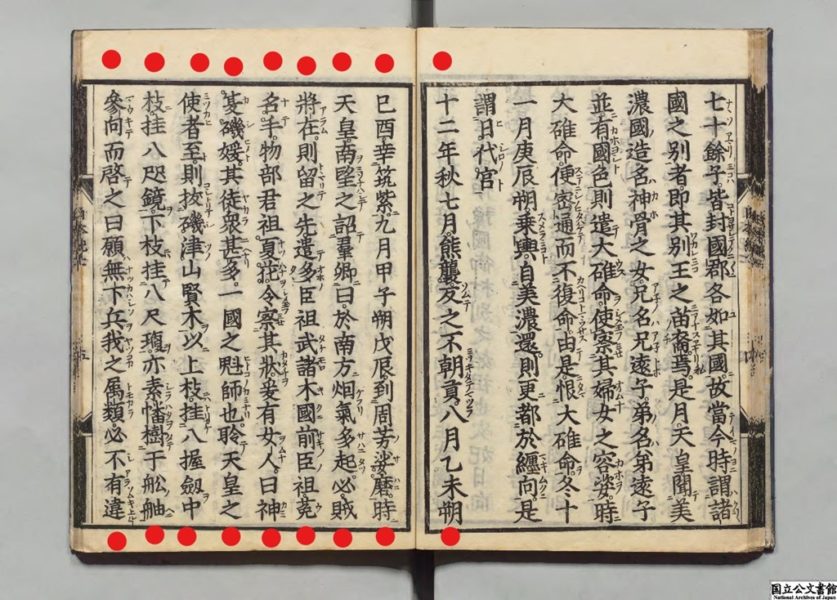
According to the company's legend, it is called the "常世長鳴鶏" that was collected and sounded at the time of "Amaterasu Okami's Heaven Iwatogakushi," which is famous for "Japanese mythology." It is said to be the birthplace of Kuro-Kashiwa. Kurohashiwa is designated as a natural monument and is raised in the precincts.
玉祖神社(tamanoya shrine)(防府市)に「拝 (hai)」(Hang your head down to 90 degrees.)
